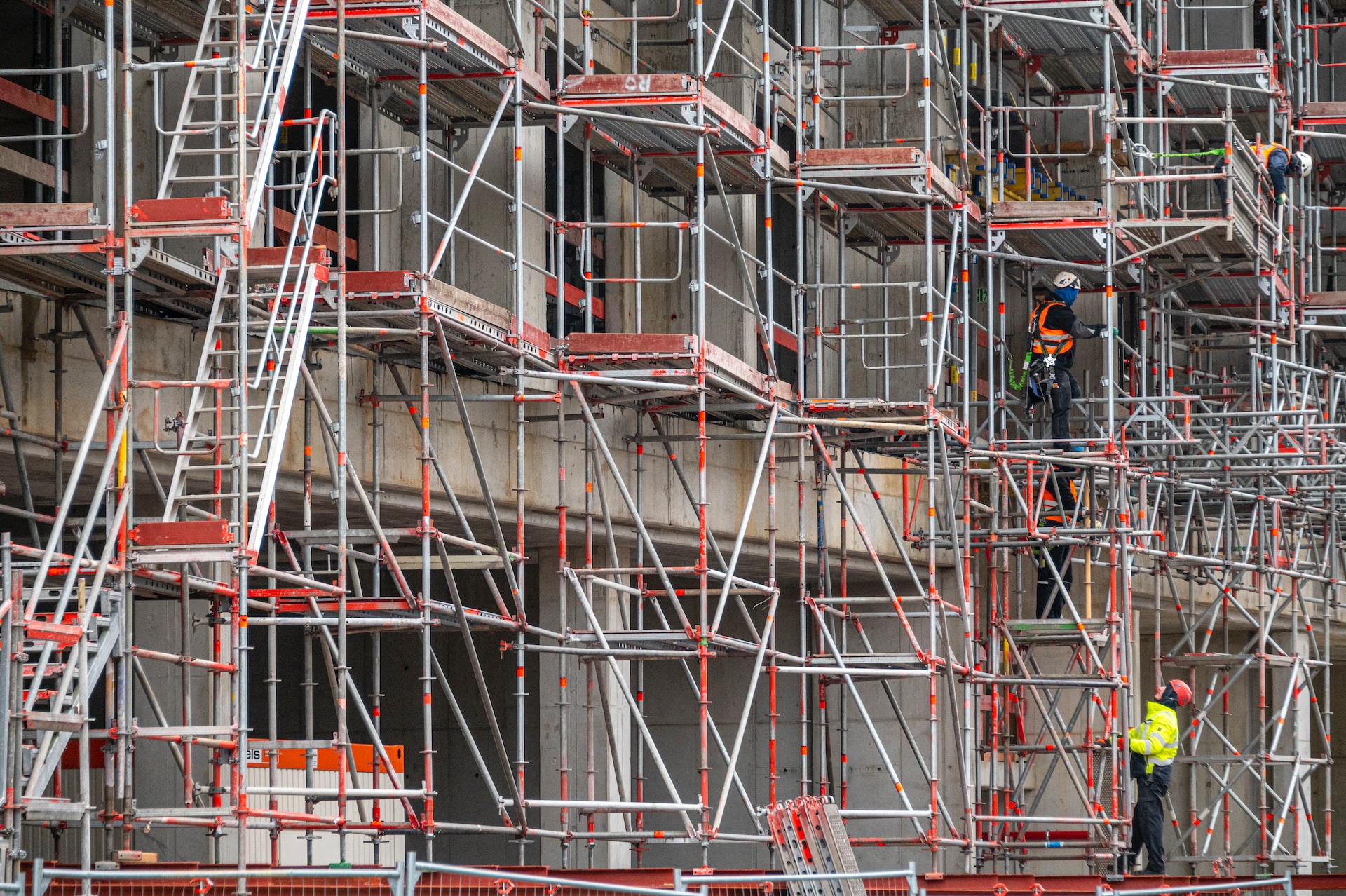Find Reliable Scaffolding Services in Surrey for Your Project Needs
A Comprehensive Overview to the Crucial Attributes of Scaffolding in Modern Construction
The landscape of modern-day construction increasingly counts on effective scaffolding systems that prioritize performance, safety, and development. As projects grow in intricacy, recognizing the necessary attributes of scaffolding becomes vital for ensuring employee safety and enhancing project timelines.
Types of Scaffolding
Although scaffolding systems can differ commonly in layout and application, they typically fall under several unique classifications that accommodate different building and construction needs - Scaffolding. One of the most common kinds consist of sustained scaffolding, put on hold scaffolding, and rolling scaffolding
Supported scaffolding includes platforms supported by a structure of poles, which offer a stable and elevated working surface. This type is usually utilized for jobs that need significant elevation, such as bricklaying or outside painting.
Put on hold scaffolding, on the other hand, is used for tasks requiring accessibility to high elevations, such as cleaning or repairing structure exteriors. This system hangs from a rooftop or another framework, permitting workers to lower or increase the system as needed.
Moving scaffolding features wheels that permit very easy mobility across a work website. It is particularly helpful for tasks that require constant moving, such as interior operate in big rooms.
Each kind of scaffolding is designed with details applications in mind, guaranteeing that construction jobs can be performed successfully and successfully. Comprehending these classifications is crucial for picking the appropriate scaffolding system to fulfill both job needs and site problems.
Key Safety Functions
Security is critical in scaffolding systems, as the possible threats associated with operating at elevations can result in serious mishaps otherwise effectively managed. Trick security attributes are important to ensure the health of employees and the integrity of the building and construction site.
First and leading, guardrails are important. These obstacles offer a physical secure versus drops, substantially reducing the threat of serious injuries. Furthermore, toe boards are usually utilized to protect against tools and materials from dropping off the scaffold, safeguarding workers below.
An additional essential component is using non-slip surfaces on systems. This feature boosts grip, specifically in unfavorable weather, thus reducing the possibility of slides and drops. Additionally, gain access to ladders must be firmly placed to assist in safe entry and leave from the scaffold.
Routine inspections and upkeep of scaffolding systems are likewise important. These examinations make certain that all components remain in good problem and working appropriately, addressing any type of wear or damages without delay.
Finally, correct training for all personnel included in scaffolding operations is important to make certain that they recognize safety protocols and can identify potential threats. Scaffolding. Jointly, these attributes create a much safer working setting and dramatically minimize risks linked with scaffolding
Material Innovations
Innovations in product science have actually significantly affected the scaffolding sector, improving both safety and security and performance in modern-day building. The introduction of high-strength steel and light weight aluminum alloys has changed typical scaffolding systems.
In addition, cutting-edge composite products, such as fiberglass-reinforced plastics, have arised as practical choices. These materials are immune to rust and ecological destruction, thus expanding the life-span of scaffolding systems, specifically in severe weather. Using such materials adds to decrease maintenance prices and ensures regular performance gradually.


Design Factors To Consider
Taking into consideration the intricacies of modern building projects, reliable scaffolding design is critical to ensuring both performance and security. Design considerations should encompass various factors, including tons capacity, height, and the details requirements of the building site. Each task offers special difficulties, requiring a versatile approach to scaffolding systems that can adjust to differing problems.
Structural stability is critical; therefore, designers need to calculate the tons that the scaffolding will sustain, consisting of employees, products, and tools. The choice of materials plays a vital role in making certain the scaffolding can stand up to these tons while remaining long lasting and lightweight. Furthermore, the design must enable very easy accessibility Bonuses and egress, facilitating the smooth activity of personnel and materials.
Safety and security functions, such as guardrails and non-slip surfaces, should be integrated to minimize risks of mishaps. Furthermore, the design must take into consideration the surrounding atmosphere, consisting of adjacent structures and potential threats. By addressing these style factors to consider, construction firms can improve the efficiency of scaffolding systems and promote a more secure working setting, ultimately adding to the total success of the project.
Upkeep and Examinations
The performance of scaffolding systems extends past first style and execution; continuous upkeep and routine examinations are crucial to guaranteeing their proceeded efficiency and safety throughout the period of a task. Normal assessments ought to be carried out by qualified employees to determine any signs of wear, damage, or instability that can jeopardize the stability of the scaffolding.
Maintenance procedures need to include regular checks of structural parts, such as installations, frameworks, and slabs, making certain that all aspects remain secure and cost-free from corrosion or other wear and tear. Furthermore, the functionality of safety features, such as guardrails and toe boards, should be analyzed to guarantee compliance with safety and security policies.
Documents of all assessments and maintenance tasks is important for responsibility try here and governing compliance. A methodical approach to record-keeping not just aids in tracking the problem of the scaffolding however additionally provides necessary evidence in the event of a case.
Eventually, establishing an extensive upkeep and inspection routine will substantially lower the risk of mishaps and improve the total security of the construction website. By prioritizing these methods, building and construction supervisors can protect employees and maintain the task's integrity.

Conclusion
Finally, the vital features of scaffolding in modern building include a variety of critical aspects, including varied types, essential security systems, material developments, and thoughtful layout considerations. Emphasizing security through guardrails and non-slip surface areas, along with improvements in materials like high-strength steel, improves both performance and sustainability. Regular upkeep and inspections are crucial for ensuring structural integrity and safety and security on building and construction websites, inevitably assisting in efficient project implementation and advertising the wellness of employees.
The landscape of modern-day building progressively relies on efficient scaffolding systems that prioritize development, effectiveness, and security.Advancements in product scientific research have actually considerably affected the scaffolding sector, improving both security and effectiveness in modern-day construction. On the whole, these product developments not only improve the efficiency and security of scaffolding systems yet likewise line up with the industry's press in the direction of sustainability, as several modern-day materials are made to be more ecologically pleasant.
Taking into consideration the intricacies of contemporary building and construction tasks, effective scaffolding design is paramount to making sure both performance and safety.In conclusion, the vital functions of scaffolding in contemporary construction encompass a variety of essential aspects, including varied types, key safety mechanisms, product technologies, and thoughtful layout factors to consider.